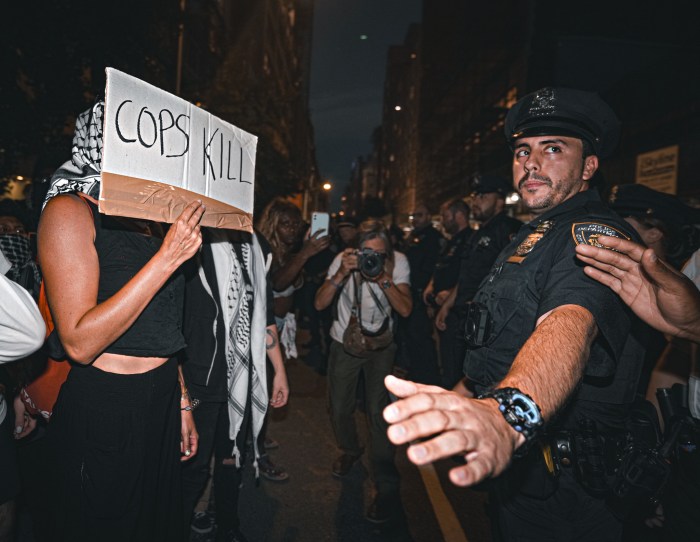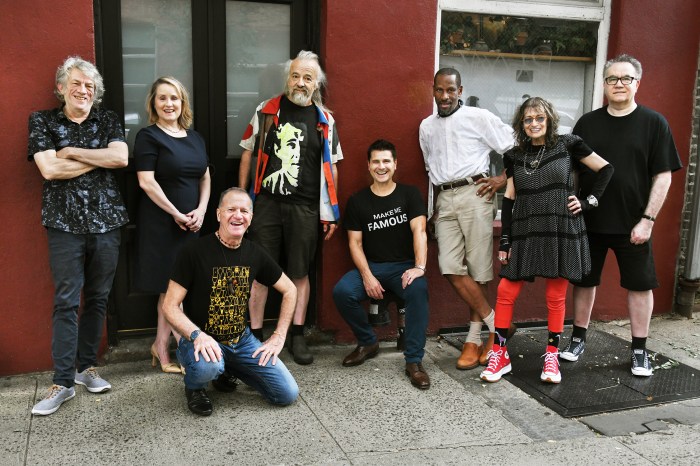By Ronda Kaysen
“I want to scare people into doing something,” said Yasmin Hernandez, sipping a cup of peppermint tea at Colonial Café on E. Houston St. “With technology and the media, we’re socialized to be complacent people. We’re socialized not to react or to know how to react. I want my art to challenge complacency.”
Hernandez, a 29-year-old, Puerto Rican native New Yorker with huge, almond eyes and thick tresses of curly black hair, does not — at first glance — look like a political activist. But beneath the cheerful demeanor is a fiery artist whose work conveys a deep sense of political injustice and a commitment to New York City’s various Puerto Rican communities, including the East Village.
Her latest project, “Musical Warriors,” pays homage to politically active musicians like Fela Kuti, the Nigerian founder of Afro-Beat whose mother was killed as retribution by the Nigerian army.
As Hernandez looks for funding for her latest project, she is reaching out directly to the Puerto Rican communities — rather than traditional arts funding sources.
“Because this project has such a social justice element to it, I thought I’d have a much better chance of getting support if I go to community organizations,” she said.
In September 2003, her mentor, Juan Sanchez, a former Guggenheim fellow and longtime Village and Lower East Side artist who teaches art at Hunter College, invited Hernandez to take part in a new project called RICANdition, addressing the effects of colonialism on Puerto Rico. RICANdition grew out of the Puerto Rican Equation, a cultural organization founded 10 years ago by Sanchez and his brother Samuel.
With the help of Hernandez and artist Miguel Luciano, Sanchez plans to enlist several artists to create posters “to deal with the colonial crisis in Puerto Rico,” he said.
“[Hernandez] is doing incredible work not only as a visual artist, but also as a cultural advocate,” said Sanchez, once an artist-in-residence at the Henry Street Settlement. His work has appeared at the New Museum in Chelsea, the Alternative Museum on the Lower East Side and Exit Art when it was in the West Village. “She goes out of her way to make the work accessible,” he said of Hernandez. “She has a commitment to the community.”
The poster Hernandez created for RICANdition is a haunting image of a female political prisoner, the shadows across her face cast by the bars that imprison her evoking the Puerto Rican flag. “When you think of prisoners, you never think of a female prisoner,” she said. “You never think of teachers and artists and mothers and women.”
Several of her paintings pay homage to Puerto Rican nationalist Lolita Lebrón, who spent 25 years in prison for firing gunshots inside the United States Congress in a 1954 protest.
In 1999, Hernandez took part in a show at Clemente Soto Velez Cultural Center on Suffolk St., a Latino-run arts center that has been mired in a dispute with Artists Alliance, a coalition of mainly white artists who also claim rights to the city-owned building the two groups share.
The row about the affordable performance and studio space embodies an ongoing struggle for Puerto Ricans in New York, said Hernandez. “We don’t have the funding and we don’t have the resources,” she said, describing Puerto Ricans as “one of the worst-faring groups in the city.”
On a recent Friday night, Hernandez introduced herself as an angry Boricua — diminutive for Puerto Rican — to laughs from the mainly Latino crowd at a lecture she gave at the Puck Building, organized by the Alliance of Latino and Latin American Students, a graduate student union.
“She is such a talented artist,” said Theresa Santiago, ALAS president, who organized the event. “I found it amazing that she had never spoken at a New York City college.” She has, however, conducted workshops at Swarthmore and Penn State.
One painting Hernandez discussed juxtaposed an image of a formally clad Latino-American soldier opposite a disheveled, haunted Vietnam veteran. Typical of Hernandez’s work, the two central images are surrounded by a dense collage of visual and literary imagery.
Nuyorican Poets Café and Vietnam veteran Pedro Pietri appears prominently in the collage. A symbol of the disproportionate number of Latinos in the military, Pietri died in 2004 of stomach cancer that he attributed to Agent Orange exposure.
Perhaps the most chilling of her paintings is the bloody trunk of a headless, limbless female body tacked to a wooden cross, a nod to a spate of unsolved murders of young women in Ciudad Juarez, a Mexican border town. “Think about what NAFTA has to do with this,” she said, referring to the rise in young girls heading north alone for work under the trade agreement and the predators who prey on them.
Hernandez makes no excuses for creating art about such disturbing topics: “There are many pretty images out there anyway, so why create more of it?” she said simply.





































